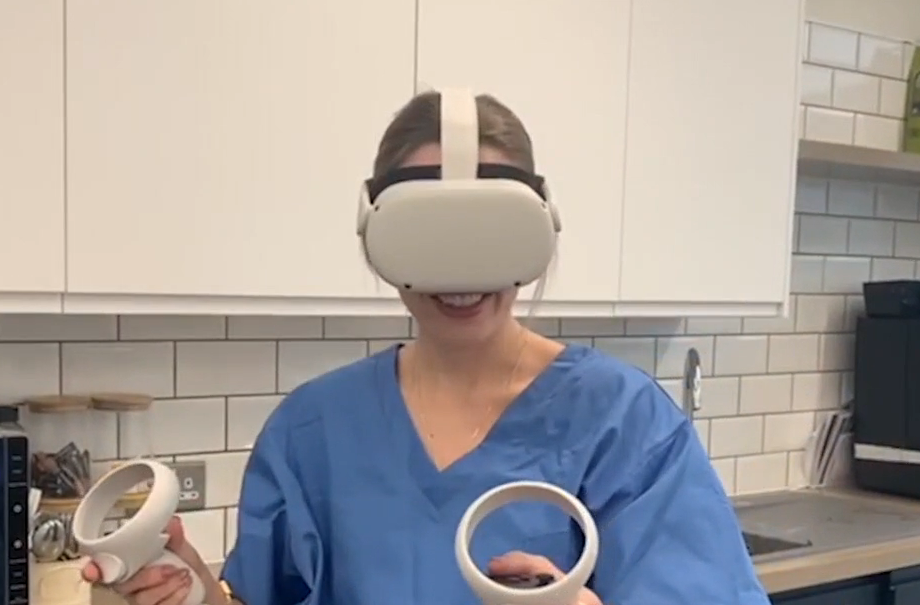The Knights Templar Eye Foundation Pediatric Ophthalmology
Virtual Reality (VR) Simulation Program
The KTEF Pediatric Ophthalmology VR Simulation Program is a first-of-its-kind educational initiative, offering free, open, cutting-edge simulation training to ophthalmologists worldwide through the use of VR headsets, other hardware, and web browsers widely available to consumers.
The VR program will provide residents, trainees, and practicing ophthalmologists with a simulated and safe learning environment that targets our youngest patients and diseases critical to pediatric eye care, and pushes beyond the boundaries of two-dimensional spatial learning.
Through this sponsored program from the Knights Templar Eye Foundation of $5Million over 10 years, the Academy plans to build both a virtual ecosystem and the first simulated ophthalmic patient encounters designed specifically for children’s eye care, including but not limited to retinopathy of prematurity (ROP) and strabismus surgery.
The platform will be robust enough to support these first groundbreaking simulators and eventually patient encounters that span the spectrum of ophthalmology. The platform will benefit trainees across the globe, providing an individualized learning path for students on their own time. By first practicing skills in a virtual environment, residents and fellows will be better prepared to manage childhood eye diseases, reducing the risk of complications in patients and accelerating their competency from classroom to the clinic and operating room.
Why is VR simulation needed in pediatric ophthalmology education?
In the medical simulation field, studies show that students gain more knowledge, retain that knowledge, and apply it more quickly and competently with VR than two-dimensional web-based or traditional print education. Virtual reality has been used extensively in surgical training programs and is increasingly being used in healthcare education and to provide objective clinical assessments of resident core competencies. Studies of dozens of randomized controlled trials during the past 10 years have also found that high-fidelity simulation (like VR) is more effective than low-fidelity simulation (such as web-based activities) for teaching clinical skills.
By using a program that simulates clinical patient encounters in lieu of a young, vulnerable patient, and having the unique ability to confront a wide variety of childhood eye diseases—some rarely seen in clinic—residents and fellows will advance their knowledge and skills without risk to the patient.
Retinopathy of prematurity remains one of the most heartbreaking eye diseases in infants—an infant who survives the challenges of prematurity only to be potentially blind or visually impaired. As smaller and smaller premature infants survive, the percentage with ROP increases and reaches epidemic proportions in some parts of the world. And this is only one of the ophthalmic diseases that specifically impacts infants and children.
This program will initially focus on ophthalmology resident pediatric ophthalmologists in training, providing a powerful new tool for students and lifelong learners who need to understand how to diagnose eye disease in children and treat them with care and competently.
How are simulators used today, and how do we anticipate these simulations could change the way patient care is provided?
Learning how to approach pediatric patients, understanding how various conditions present, and mastering the skills of various examination techniques can be achieved only by practice, repetition, and feedback. Usually this is achieved by seeing many patients with similar conditions, shadowing another more senior physician, and mentorship.
Simulators allow ophthalmologists to observe the infinite variation of conditions, such as eye misalignment and refractive error, while alleviating the need to see conditions in a real patient. In pediatric patients, who are often challenging enough to examine and treat for many clinicians, simulation is a fundamental educational paradigm.
Simulators also allow communities of learners and faculty to engage together remotely, sharing and teaching in real-time through the same system. Sometimes it takes months or even years to see patients with various conditions—some childhood eye disorders are rare and unlikely to present during an ophthalmology residency. Video recordings of patients or photographic representations of eye disease can be educational, but they still cannot substitute for a patient’s response to an examination, or the decision-making and dexterity needed when performing surgical maneuvers.



